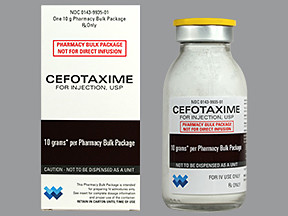CEFOTAXIME - INJECTION
PHONETIC PRONUNCIATION: (SEF-oh-TAX-eem)
COMMON BRAND NAME(S): Claforan
GENERIC NAME(S): cefotaxime sodium
Uses
USES: Cefotaxime is used to treat a wide variety of bacterial infections. It may also be used to prevent infection from certain surgeries. This medication belongs to a class of drugs known as cephalosporin antibiotics. It works by stopping the growth of bacteria.
How to use CEFOTAXIME - INJECTION
HOW TO USE: This medication is given by injection into a muscle or vein as directed by your doctor. If given by injection into a vein, inject the drug slowly over at least 3 minutes to avoid possible serious side effects (such as irregular heartbeat). The dosage is based on your medical condition and response to treatment. If you are using this medication at home, learn all preparation and usage instructions from your health care professional. Before using, check this product visually for particles or discoloration. If either is present, do not use the liquid. Learn how to store and discard medical supplies safely. If you are using the frozen pre-mixed solution, thaw the bag at room temperature or in the refrigerator. If the bag is thawed in the refrigerator, let it sit at room temperature at least 1 hour before using. Do not thaw by putting in a water bath or microwaving. After thawing, shake well and squeeze the bag to check for leaks. Discard solution if the bag leaks. Do not re-freeze the solution after thawing. For the best effect, use this antibiotic at evenly spaced times. To help you remember, use this medication at the same time(s) every day. Continue to use this medication for the full time prescribed, even if symptoms disappear after a few days. Stopping the medication too early may result in a return of the infection. Tell your doctor if your condition lasts or gets worse.
Side Effects
Precautions
Interactions
Overdose
Images
Reviews
Faq for CEFOTAXIME - INJECTION
Cefotaxime injection is used to treat various bacterial infections such as respiratory tract infections, urinary tract infections, skin and soft tissue infections, bone and joint infections, and pelvic inflammatory disease.
Cefotaxime belongs to the class of antibiotics known as cephalosporins. It works by inhibiting the growth of bacteria and preventing their further multiplication.
The dosage of Cefotaxime injection varies depending on the type and severity of the infection. It is usually administered intravenously (into a vein) or intramuscularly (into a muscle) by a healthcare professional.
Common side effects of Cefotaxime injection may include diarrhea, nausea, vomiting, headache, dizziness, and skin rash. Serious side effects such as allergic reactions or severe diarrhea should be reported to a healthcare provider immediately.
Cefotaxime injection is generally considered safe to use during pregnancy and breastfeeding. However, it is important to consult with a healthcare provider before using any medication during these periods.
If you miss a dose, contact your healthcare provider for instructions. It is important to follow the prescribed dosage schedule to ensure the effectiveness of the medication.
Yes, Cefotaxime injection can be used in children. The dosage may be adjusted based on the child's weight and the severity of the infection. It is important to follow the pediatric dosing instructions provided by a healthcare professional.
It is generally recommended to avoid consuming alcohol while taking Cefotaxime injection. Alcohol may interact with the medication and increase the risk of side effects.
The onset of action of Cefotaxime injection varies depending on the individual and the infection being treated. Improvement in symptoms is typically observed within 24 to 48 hours of starting the medication.
Disclaimer
IMPORTANT: HOW TO USE THIS INFORMATION: This is a summary and does NOT have all possible information about this product. This information does not assure that this product is safe, effective, or appropriate for you. This information is not individual medical advice and does not substitute for the advice of your health care professional. Always ask your health care professional for complete information about this product and your specific health needs.


No Reviews Yet